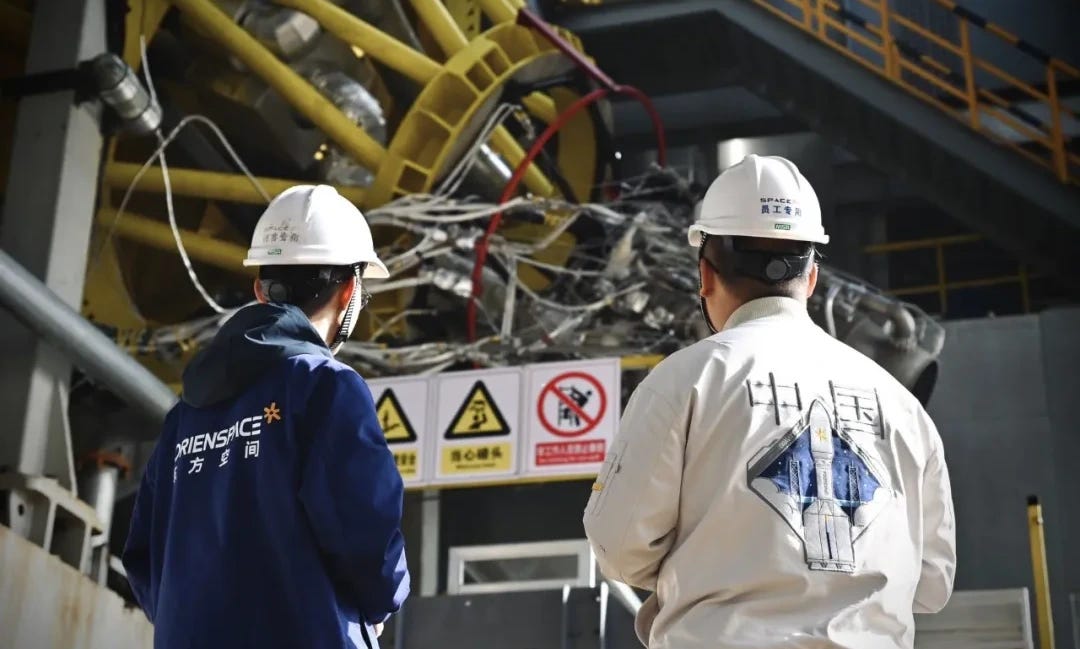OrienSpace, iSpace Reusable Rockets Inch Forward as 2025 Debuts Slip Away
Engine restarts and fairing separations slightly push development forward.
Two of China’s reusable rockets are making progress, but are unlikely to fly before 2026 with their current development.
OrienSpace shared on November 12th that it conducted another test with a nozzle-less Yuanli-110 engine, burning rocket-grade kerosene and liquid oxygen to produce 110 tons of thrust, to demonstrate its restart capabilities for the in-development reusable Gravity-21 two-stage launch vehicle.
For the test, two brief firings were conducted to demonstrate the engine’s ability to cleanly start up and shut down without needing the intervention of engineers for both processes. OrienSpace says that the test proved the restart capability. Demonstrating that Yuanli-110 engines can restart themselves is critical for recovering Gravity-2’s first-stage boosters as they land after supporting a launch mission.
In September, the Yuanli-110 engine conducted its first proper test firing after burning propellants through its gas generator.
OrienSpace still publicly believes that a 2025 debut flight for Gravity-2 is possible, but that is an extremely ambitious target as today’s test inches development forward. The first handful of flights will not use the company’s engine; instead, the Academy of Aerospace Liquid Propulsion Technology’s (航天推进技术研究院) rocket-grade kerosene and liquid oxygen burning YF-102. With a herculean effort, Gravity-2 could have both of its first and second stages ready for static fires before the end of the year, then for flight in 2026.
Published a few hours after OrienSpace’s test, iSpace also inched towards the maiden flight of its two-stage reusable launch vehicle, Hyperbola-32, with a separation test of its 5.2-meter diameter fairing. According to the company, the test verified the design choices for the separation scheme, subsequently stating:
“The separation process proceeded smoothly, with complete data acquisition. All performance metrics met design specifications, marking the test a complete success.”
If there are any problems with this translation please reach out and correct me.
Last month, iSpace opened its launch vehicle processing and refurbishment facility at the Wenchang Commercial Space Launch Site to support missions with Hyperbola-3. Before that, the company launched its drone ship for recovering first-stage boosters, alongside cryogenic proof testing of propellant tanks.
Despite a busy year, iSpace is yet to share news of a completed Hyperbola-3 vehicle, or either stages for pre-flight static fires. With seven weeks left in the year, it’s unlikely the reusable rocket will debut in 2025, but they are marginally ahead of OrienSpace.
With OrienSpace and iSpace likely out of the running, China’s commercial space sector’s race to fly a reusable rocket is now between Space Pioneer with Tianlong-3, LandSpace with Zhuque-3, Galactic Energy with Pallas-1, and CAS Space with Kinetica-2 (although reuse will be after a few flights).
Set to deliver up to 17,400 kilograms to low Earth orbit with a reusable booster, or 21,500 kilograms to low Earth orbit when expended.
Planned to send 13,600 kilograms to low Earth orbit when expended or 8,600 kilograms to low Earth orbit with first-stage reuse.



